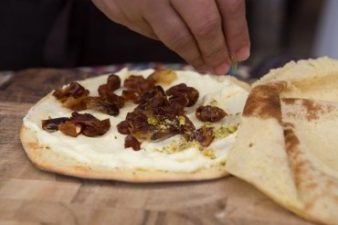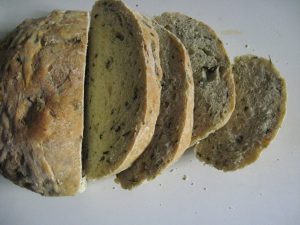Physicist and video-game inventor Seamus Blackley enjoys studying Egyptology and baking sourdough bread. That’s not all he does. Recently, he succeeded in physically traveling through time. That is, he baked bread from an original, 5000-year-old Egyptian yeast culture, and with flour milled from the grains the ancients would have used. Eating history. That’s as close to time-travel as you can get.
Together with microbiologist Richard Bowman of the University of Iowa and archeologist Serena Love of the University of Queensland, Blackley obtained permission from Boston’s Museum of Fine Arts and Harvard’s Peabody Museum in Massachusetts to collect yeast from their collections of ancient Egyptian pottery.
The yeasts have lain dormant inside the clay pots since the last time bakers used them to make dough rise: about five thousand years ago. In an interview with the London Times, Blackely explained how he collected it.
“You pump a fluid in carefully with a syringe and some sterile cotton in contact with the ceramics. It soaks in and you vacuum it back out.”
Most of the samples taken from the ancient vessels went off to Love and Bowman’s labs for analysis and preservation. Blackley kept some for his own experiment at home.
Blackely undertook the delicate, finicky task of creating a live sourdough starter from the 5000-year-old yeasts. To minimize contact with modern yeasts and bacteria, he sterilized all the equipment, even to the point of sterilizing the flours used to make the starter and the dough. However, he stored the semi-liquid result in an endearingly modern (sterilized) jam jar.

Voilá, a bubbly sourdough starter from yeasts woken after a millenial sleep.

The results: a delicious-looking, perfectly raised loaf of bread, marked with the hieroglyphic for bread.

Afraid that the ancient yeast culture will open the way to weird ancient diseases? Hardly. Once yeasts have done their job of making the dough rise, baking kills them. If I had the chance, I would happily sample some of that bread myself.
Blackely unfolds the whole story on Twitter. He says, “The crumb is light and airy, especially for a 100% ancient grain loaf. The aroma and flavor are incredible. I’m emotional. It’s really different, and you can easily tell even if you’re not a bread nerd. This is incredibly exciting, and I’m so amazed that it worked.”
You can follow the entire story, complete with hilarious “mummy” comments, at @SeamusBlackely. The physicist-turned-microbiologist writes entertainingly, and provides a generous number of photos of the process for bread nerds like me.
Trapping the true yeasts is an ongoing experiment. The team is determined to isolate the original culture via genetic testing. It may be possible to reproduce it without any contamination from modern airborne yeasts and bacteria. But they’re reasonably sure that the cultures already obtained have enough of the original Old Kingdom yeasts to reproduce the daily bread that people ate back then, in ancient Egypt.
The next step, Blackley says, is to bake the bread by the ancient baking methods. Presumably this means baking the dough in a charcoal-fueled oven, in the clay cones that look like our modern flower pots. This method was already successfully replicated in 1993, by American biologist and master baker Ed Wood, who flew to Cairo with a team of like-minded scientists and the archeologist Mark Lehrner for that purpose. They constructed a bakery based on a surviving ancient model and after much trial and error, baked ancient-style bread.
I’m waiting excitedly for the next phases in this experiment. Who knows, maybe some day we’ll be able to taste the bread of the ancients and do a little time-travel ourselves.





One thought on “Bread Baked With 5000-Year-Old Egyptian Yeast”
Comments are closed.